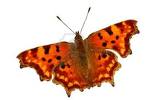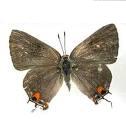Where Science, Art and Nature Come Together.
Ten Butterflies for Beginners
Butterfly identification is a learning process. It is easier to start with the large, brightly colored species and gradually work down to the small, drab ones. Here is what to look for on some of the most common species of butterflies in North America.
 Tiger Swallowtails
Tiger Swallowtails
Just about every area has at least one of the five kinds of tiger swallowtails found in North America. It is a large butterfly, bright yellow with black wings edges and black stripes that run parallel to its body. Its tiger stripes give it its surname while swallowtail describes the narrow black wing extensions that trail behind it. Plant some wild cherries, such as chokecherry or black cherry (the caterpillar’s host plant), in your yard and thrill to the sight of these spectacular beauties taking nectar at your garden lilies.
 Black Swallowtail
Black Swallowtail
These large black-and-yellow butterflies are at home in towns and gardens. Black swallowtails are found throughout the eastern two-thirds of North America. Plant a patch of parsley or dill in your garden and there is an excellent chance that you can watch the brilliant green and black-striped caterpillars grow to adulthood – even if your garden is the terrace of a high-rise apartment in a major city! Males of the two swallowtail species are drawn to the tops of hills, where they wait for females.
 Cabbage White
Cabbage White
Our small white butterflies are almost all cabbage whites, an abundant and widespread species. One of only two non-native butterflies in North America, the cabbage white is now perhaps our most common butterfly. Its caterpillars feed on a wide variety of plants, including mustards and of course, cabbage. Look for black dots on the wings, one for a male and two for a female.
 Orange Sulphur
Orange Sulphur
Replace the white of the cabbage butterfly with lemon yellow to orange color and you have the orange sulphur. The sulphurs are medium-sized butterflies whose colors range from white to orange. This species is one of the most abundant in North America, sometimes swarming in vast numbers in alfalfa fields. It is found throughout the United States and most of Canada. Its close relatives, including the common and widespread, clouded sulphur, are pure yellow above, with no trace of orange. The related giant sulphurs are much larger, almost the size of swallowtails, while the related “yellows” tend to be smaller.
 Spring Azure
Spring Azure
The brilliant blue of spring azures is a wake-up call for the winter weary butterfly enthusiast. Azures are one of the first butterflies to emerge in the spring to greet the new season and are found over most of the continent. Some of the 30 other species of blues are difficult to distinguish from this one, but only the tailed blues are likely to be found in your garden. They are darker blue above with fine tails.
 Mourning Cloak
Mourning Cloak
The mourning cloak is another large butterfly. It is the only black (or very dark brown) butterfly with yellow wing edges. Because it overwinters as adults, they are another early appearing butterfly. They can sometimes be seen on an extremely warm day in January. They will become plentiful again in mid-July. The adults do not usually visit flowers but are partial to tree sap and various decaying organic matter. The caterpillars feed mainly on willows.
 Question Mark and Comma
Question Mark and Comma
These butterflies are named for the silvery marks in the middle of the underside of their hind wings, which resemble certain punctuations marks.
 Monarch
Monarch
This is the best-known butterfly in North America. Large and brightly colored in orange and black, these butterflies cause everyone’s head to turn as they migrate southward in large groups in the fall. They are such strong fliers that they colonized New Zealand, Australia, and the Canary Islands! Adult monarchs are distasteful to birds because the caterpillars feed on milkweeds and accumulate toxic chemicals. Because these butterflies retreat to Mexico for the winter, they are not common around here until late June. In fact, most entomologists agree that the “returning” butterflies are offspring of those that flew south last fall.
 Viceroy
Viceroy
Although unrelated to the monarch, the viceroy takes advantage of the monarch’s unpalatability by mimicking its appearance. At first glance, it looks very similar to a monarch butterfly. It is slightly smaller than the monarch, with which its almost identical orange and black pattern is easily confused. However, unlike the monarch, the viceroy has a black stripe on the hind wing that crosses the other lines.
 Gray Hairstreak
Gray Hairstreak
Hairstreaks are wonderfully vast group with more than 1,000 species found in the American tropics. About 60 species are found in North America, the most widespread being the gray hairstreak. Its caterpillars have one of the broadest tastes of any butterfly, but seem especially to enjoy various mallows, including hollyhocks. Some other hairstreaks have a similar bright orange spot on the hind wing below, but few are as evenly gray as this species.